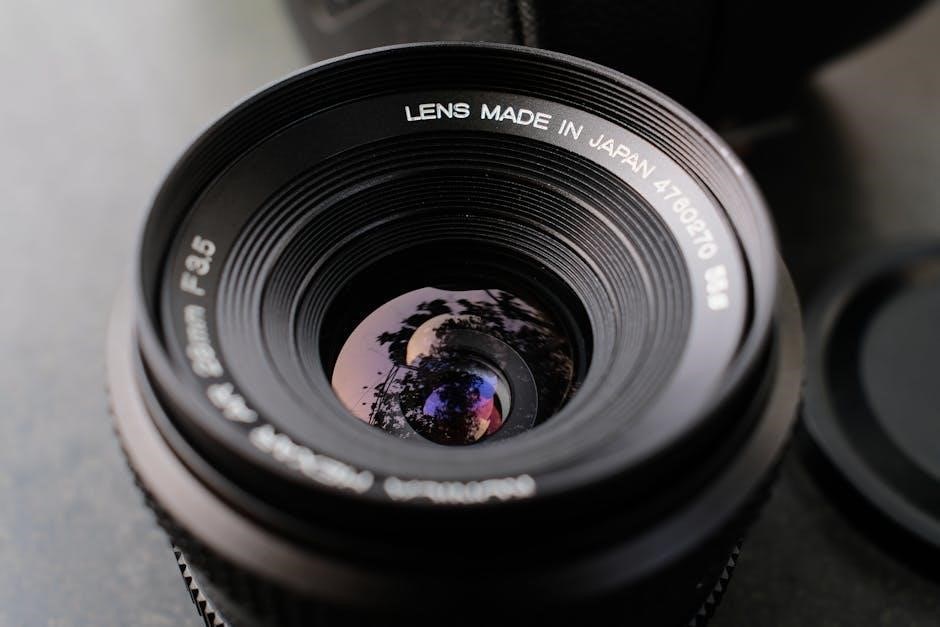
Olympus TG-6 Manual: A Comprehensive Guide
Welcome to the comprehensive guide for the Olympus TG-6, a rugged and versatile compact camera! This guide will explore everything from initial setup to advanced techniques, ensuring you get the most out of your camera.
The Olympus TG-6 is a robust and reliable compact camera, celebrated for its exceptional durability and image quality, making it a favorite among adventurers and outdoor enthusiasts. Its waterproof design allows submersion up to 15 meters without additional housing, perfect for underwater photography. The camera boasts a high-resolution 12-megapixel sensor, capturing crisp and detailed photos in various conditions.
Its macro capabilities, including a microscope mode, enable users to capture stunning close-up shots of tiny subjects. With user-friendly controls and a comprehensive menu system, the TG-6 caters to both beginners and experienced photographers. This guide aims to unlock the full potential of your TG-6.
Accessing the Olympus TG-6 Manual
The Olympus TG-6 manual is readily available in digital format, offering convenient access to comprehensive information about your camera. You can easily download the manual from the official Olympus website, ensuring you always have a reliable resource at your fingertips. The digital manual is typically available as a PDF file, which can be viewed on computers, tablets, and smartphones.
Additionally, the Olympus Image Share app may provide direct access to the manual, streamlining the process further. Having the manual on your smartphone allows for quick reference in the field, assisting with troubleshooting and optimizing camera settings. The manual includes detailed instructions on everything from basic operations to advanced features;
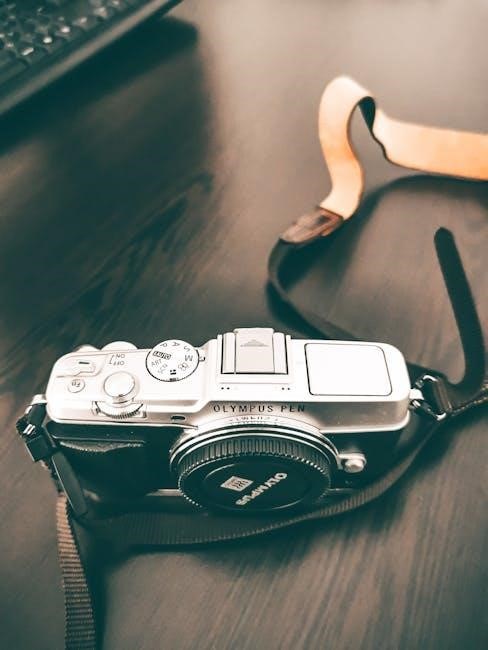
Preparation
Before diving into photography, prepare your Olympus TG-6! This includes charging the battery, inserting an SD card, and understanding basic functions for optimal performance and to avoid common issues.
Initial Setup and Basic Operations
The Olympus TG-6 is renowned for its ruggedness and ease of use, making it an excellent choice for both beginners and experienced photographers. To begin, ensure the battery is fully charged using the provided USB cable and adapter. Next, insert an SD card to store your photos and videos; the TG-6 supports SD, SDHC, and SDXC cards;
Power on the camera by pressing the power button. The initial setup will guide you through setting the date, time, and language. Familiarize yourself with the mode dial, which offers various shooting modes. For basic photography, the ‘i-Auto’ mode is perfect for automatically adjusting settings. Use the zoom lever to frame your shot, and press the shutter button halfway to focus, then fully to capture the image. Explore the menu system by pressing the ‘Menu’ button to customize settings further.
Remember to consult the complete manual for detailed instructions!
Understanding the Camera’s Buttons and Dials
Mastering the Olympus TG-6 begins with understanding its physical controls. The mode dial, located on the top, allows you to quickly switch between shooting modes like ‘i-Auto,’ ‘Program,’ ‘Aperture Priority,’ and ‘Underwater.’ The shutter button, also on top, captures photos, while the zoom lever adjusts the focal length.
On the back, you’ll find the directional pad, used for navigating menus and accessing features like flash settings, self-timer, and focus mode. The ‘Menu’ button opens the main menu, while the ‘Info’ button displays shooting information. The ‘Playback’ button allows you to review captured images and videos. The ‘OK’ button confirms selections. Pay attention to the customizable function button (Fn), which can be assigned to frequently used settings. The record button, usually red, initiates video recording. Familiarizing yourself with these controls is crucial for efficient operation and creative control. The manual provides detailed diagrams and explanations of each button’s function.
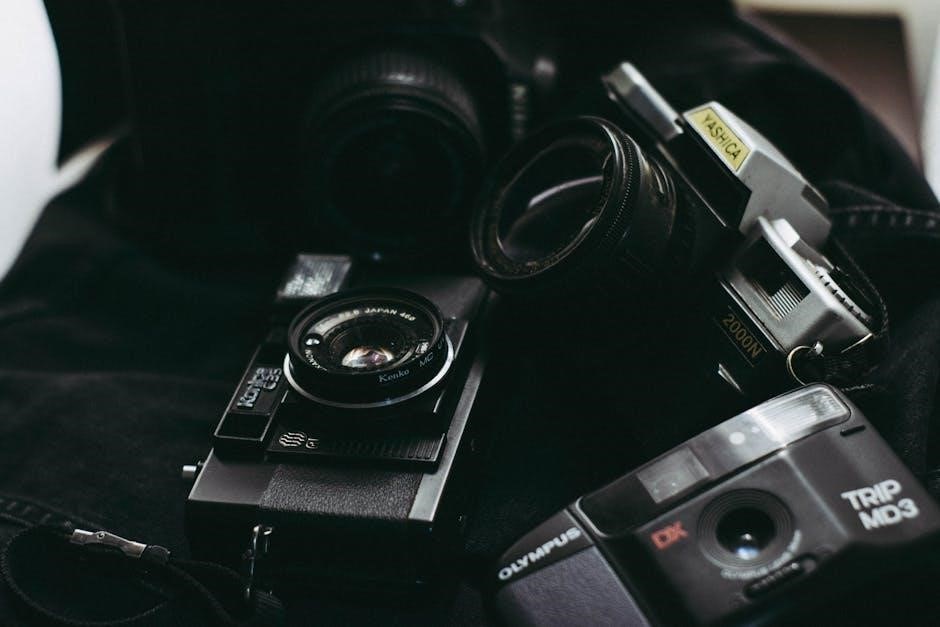
Shooting
This section delves into the art of capturing stunning images with your Olympus TG-6. We will explore various shooting modes, underwater photography techniques, and the unique macro capabilities of this versatile camera.
Exploring Shooting Modes
The Olympus TG-6 boasts a variety of shooting modes, catering to different scenarios and creative visions. Understanding these modes is crucial for maximizing the camera’s potential. i-Auto mode simplifies photography by automatically adjusting settings based on the scene. Program mode offers more control while still automating aperture and shutter speed.
Aperture Priority allows you to control the depth of field, while Shutter Priority lets you freeze motion or create motion blur. Manual mode provides complete control over all settings for experienced photographers. Scene modes offer presets optimized for specific situations, such as portrait, landscape, and night scenes.
Additionally, the camera features custom modes for saving your preferred settings. Experimenting with these modes will help you discover the best approach for various photographic opportunities. The underwater mode is specifically designed for capturing vibrant underwater images, while the microscope mode excels at extreme close-up photography.
Underwater Photography with the TG-6
The Olympus TG-6 excels in underwater photography, offering remarkable capabilities without requiring additional housing up to 15 meters. To begin, select the Underwater mode on the mode dial for optimized settings. The TG-6 provides specific underwater sub-modes, including Underwater Snapshot for quick shots, Underwater Wide for expansive scenes, and Underwater Macro for close-up details.
Underwater Microscope mode enables extreme magnification, revealing hidden details of marine life. Underwater HDR mode enhances dynamic range, capturing balanced exposures in challenging lighting conditions. Remember to thoroughly rinse the camera with fresh water after each dive to prevent salt buildup and maintain water resistance.
Consider using red filters to counteract the loss of red light underwater, enhancing color vibrancy. Pay attention to buoyancy and composition for stunning underwater images. Exploring these underwater features will unlock a world of photographic opportunities beneath the surface. Ensure the camera’s seals are clean and properly maintained for worry-free underwater adventures.
Macro and Microscope Modes
The Olympus TG-6 shines in capturing intricate details through its dedicated macro and microscope modes. These modes enable users to photograph subjects up close with stunning clarity. Activate the macro mode to focus on subjects just a few centimeters away, revealing textures and patterns invisible to the naked eye. For even greater magnification, the microscope mode transforms the TG-6 into a portable microscope.
This mode allows extreme close-ups, capturing minute details like the structure of plant cells or the facets of an insect’s eye. Manual Focus Assist and Focus Peaking further enhance focusing precision, ensuring sharp images even at high magnifications. Adjust the number of stacked images in Focus Stacking for optimal depth of field.
Experiment with external lighting to illuminate your subjects and minimize shadows. The TG-6’s close focusing capabilities combined with these features make it an exceptional tool for exploring the micro-world. Remember to stabilize the camera or use a tripod to prevent blur when shooting at high magnifications.

Playback
The Playback function allows you to review captured images and videos directly on the camera’s screen. Navigate through your media, zoom in for details, and share your adventures.
Reviewing Images and Videos
After capturing stunning photos and videos with your Olympus TG-6, reviewing them is simple and intuitive. Press the playback button, typically indicated by a triangle icon, to enter playback mode. You can then scroll through your images and videos using the directional buttons. Zoom in on photos to check focus and details, ensuring your shots are crisp and clear.
For videos, press the OK button to start playback, and use the same button to pause or stop. The TG-6 also allows you to trim videos directly on the camera, removing unwanted sections. You can also delete unwanted images to free up storage space on your memory card.
The camera also displays shooting information, such as aperture, shutter speed, and ISO, allowing you to learn from each shot. You can even protect your favorite images from accidental deletion. Furthermore, you can rotate images for proper viewing. The Olympus TG-6 makes reviewing your media a seamless and enjoyable experience.
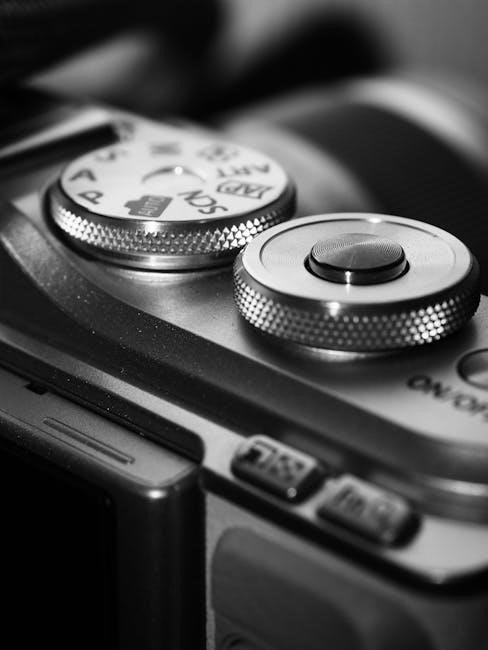
Menu Functions
The Olympus TG-6 boasts a comprehensive menu system. It gives users control over various camera settings. Navigating these menus unlocks the full potential of the camera, and customizes the shooting experience.
Navigating the Menu System
Understanding the Olympus TG-6’s menu system is crucial for unlocking its full potential. To access the menu, press the ‘Menu’ button on the camera’s rear. The menu is structured into several tabs, each containing related settings. Use the arrow pad to navigate between tabs and menu items.
The ‘Shooting Menu’ allows you to adjust image quality, white balance, and ISO settings. The ‘Playback Menu’ provides options for reviewing and managing your photos and videos. The ‘Setup Menu’ contains general camera settings.

Press the ‘OK’ button to select a menu item and modify its value. Some settings offer multiple options, while others require numerical input. Once you’ve made your changes, press ‘OK’ again to save them. Familiarizing yourself with the menu layout will allow you to quickly access and adjust settings. It helps to adapt the camera to your specific needs and shooting conditions;
Customizing Camera Settings
The Olympus TG-6 offers a wealth of customizable settings to tailor the camera to your preferences. Start by exploring the ‘Custom Menu’ for personalized controls. Assign frequently used functions to the function buttons for quick access;
Adjust the ‘Button Function’ settings to remap the camera’s buttons according to your shooting style. This allows you to access settings like white balance or ISO with a single press. Configure the ‘My Mode’ settings to save your favorite shooting modes for easy recall. This is perfect for quickly switching between landscape and portrait settings.

Customize the ‘i-Enhance’ setting to boost colors and contrast for vibrant images. Explore the ‘Custom White Balance’ option for accurate color reproduction in challenging lighting conditions. Use the ‘Interval Shooting’ feature to create time-lapse videos. Experiment with different settings to discover what works best for your style. This will help to unlock the full potential of your Olympus TG-6.

Connectivity
The Olympus TG-6 excels in connectivity, offering seamless transfer of images. Utilize Wi-Fi to connect to smartphones. Explore the benefits of Field Sensor data integration for geotagging and environmental logging.
Connecting to Smartphones via Wi-Fi
The Olympus TG-6 simplifies image sharing through its built-in Wi-Fi connectivity. By connecting to your smartphone, you can effortlessly transfer photos and videos. Start by downloading the Olympus Image Share (OI;Share) application, available on both iOS and Android platforms. Once installed, activate the Wi-Fi function on your TG-6 through the camera’s menu.
Follow the on-screen instructions within the OI.Share app to establish a connection with your camera. This will typically involve scanning a QR code displayed on the camera’s LCD screen. After a successful connection, you can browse the images stored on your TG-6 and select the ones you wish to transfer.
OI.Share also enables remote camera control. You can adjust settings like zoom and shutter release directly from your smartphone. This feature is especially useful for group shots or situations where you need to position the camera in a tricky spot. Moreover, the app facilitates easy sharing of your captured moments on social media platforms.
Using Field Sensor Data
The Olympus TG-6 is equipped with field sensors that enhance your photography experience by capturing environmental data alongside your images. These sensors include a GPS, compass, manometer (for altitude/depth), and a temperature sensor. To utilize these features, enable the GPS and sensor logging options within the camera’s menu. Once activated, the TG-6 will record location, direction, altitude/depth, and temperature information with each shot.
This data can be invaluable for outdoor enthusiasts and adventurers. The recorded information can be used to map your photographic journey, track changes in altitude or depth during dives, and document temperature variations. The OI.Share app can display this sensor data alongside your images, providing a comprehensive record of your experiences.
Furthermore, you can export the sensor data for use in other applications, such as mapping software or data analysis tools. This allows you to create detailed visualizations of your travels and gain insights into the environments you’ve photographed. The field sensor data adds a new dimension to your images, transforming them into rich, informative documents of your adventures.
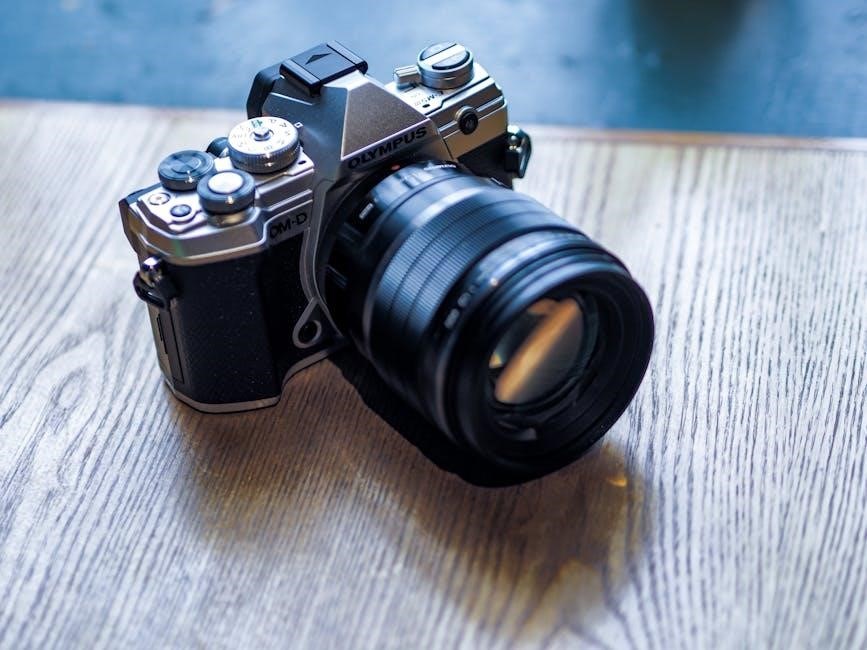
Troubleshooting
Encountering issues? This section addresses common problems with your Olympus TG-6, offering practical solutions. From battery issues to connection problems, find the answers here to resolve difficulties quickly.
Common Issues and Solutions
This section addresses the most frequently encountered issues users face with the Olympus TG-6. One common problem is fogging within the lens, often due to temperature changes; ensure proper drying after underwater use and consider using anti-fog products. Another issue is battery drain; optimize settings and carry spare batteries.
Connectivity problems with smartphones can occur; ensure Wi-Fi is enabled and the Olympus Image Share app is correctly installed. If the camera freezes, try removing and reinserting the battery. For image quality concerns, check your shooting mode and lighting conditions.
If the camera doesn’t power on, verify the battery is charged and correctly inserted. Addressing these common issues will help maintain optimal performance and longevity for your TG-6. Always refer to the complete manual for detailed guidance.

Specifications
This section details the technical specifications of the Olympus TG-6, including sensor size, lens details, dimensions, weight, and other important hardware and software information for advanced users.
Technical Specifications of the TG-6
The Olympus TG-6 boasts a 12-megapixel sensor, ensuring crisp, detailed images. Its lens offers a 4x optical zoom. The camera is waterproof up to 15 meters without needing a separate housing. It supports SDXC cards for ample storage.
Connectivity includes Wi-Fi for seamless smartphone integration. The TG-6 features a 3.0-inch LCD screen for easy review of images. It captures videos in 4K resolution. The camera’s dimensions ensure portability.
Additional features include GPS for geotagging and various shooting modes. The TG-6’s rugged design makes it ideal for outdoor adventures. Manual focus is possible with assist and peaking features.
The camera’s CMOS sensor enhances image clarity while reducing noise. The TG-6 also offers focus stacking capabilities.